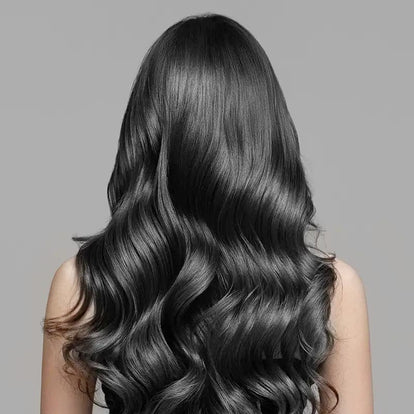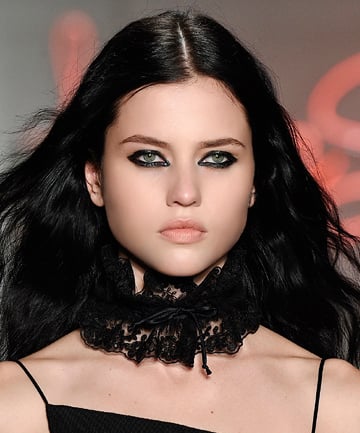To apply semi permanent dye on black hair, understand how the chemistry works. Semi permanent dye is a direct pigment formula that coats the outer layer of the hair shaft. It does not contain ammonia or peroxide. It does not alter melanin in the cortex. Hair color scientists identify semi permanent dyes as “deposit-only” formulas. They fade gradually with washing.

Key technical attributes:
-
Pigment molecules: large, non-oxidative, and short-lived.
-
Penetration: minimal, limited to cuticle surface.
-
Longevity: approximately 6–12 washes depending on shampoo type.
-
Damage level: minimal, since no lifting or bleaching occurs.
In simple terms, semi permanent dye adds tone, reflection, or subtle hue without permanently changing the hair structure.
2. The Challenge of Coloring Black Hair
Black hair (color level 1–2) contains the highest density of eumelanin pigment.
Melanin concentration resists visible change unless the natural pigment is lightened.
Semi permanent dyes cannot remove or replace this melanin. They can only coat over it.
Scientific reason:
Eumelanin molecules absorb light in most visible wavelengths. For a pigment to show, its reflective wavelength must overpower this absorption. Hence, only very saturated, deep colors can reflect on black hair.
Practical outcome:
-
Deep violet → faint purple tint under sunlight.
-
Burgundy → subtle red tone under warm light.
-
Blue-black → visible sheen under natural daylight.
Pastel, silver, or neon pigments remain invisible on unbleached black strands.
3. Benefits of Semi Permanent Dye On Black Hair
| Benefit Type | Description |
|---|---|
| Damage Control | No ammonia or developer, leaving cuticle intact. |
| Color Refresh | Adds shine or tone to faded black dye. |
| Temporary Change | Allows experimentation without commitment. |
| Low Maintenance | Gradual fade prevents harsh demarcation lines. |
| Conditioning Effect | Some dyes include aloe vera, amino acids, or argan oil to improve texture. |
Semi permanent coloring provides a gentle way to experiment while preserving strength and elasticity of dark hair fibers.
4. Best Shades for Black or Very Dark Hair
Not every color reads clearly on a black base. Select hues that maintain saturation and contrast.
Recommended visible shades:
-
Deep Burgundy
-
Blue-Black
-
Dark Violet
-
Plum
-
Eggplant
-
Mahogany
-
Black Sapphire
-
Copper-Brown (adds warm reflection)
Avoid invisible shades:
-
Pastel pink
-
Silver
-
Rose gold
-
Neon green
-
Baby blue
Brands like Manic Panic, Arctic Fox, Splat Midnight, L’Oréal Colorista, and John Frieda Midnight Gloss offer rich formulas that deposit intense pigment without bleaching.
5. Preparation Before Application
To achieve even results, prepare hair properly before coloring.
-
Clarify the hair shaft.
Remove buildup from oils, silicones, or styling products using a sulfate-free clarifying shampoo. -
Skip conditioner before dyeing.
Conditioner seals cuticles, preventing pigment adhesion. -
Perform a strand test.
Observe actual shade visibility on one small section before full application. -
Dry hair completely.
Wet strands dilute pigment concentration and cause uneven staining. -
Protect surroundings.
Use petroleum jelly on hairline and gloves on hands to avoid staining skin.
Proper preparation ensures maximum pigment deposition even on resistant black hair.
6. Step by Step Application Guide
To color black hair using semi permanent dye:
-
Section the hair.
Divide into four quadrants for thorough coverage. -
Apply the dye generously.
Start from roots, comb through to distribute pigment evenly. -
Use moderate heat.
Cover hair with a processing cap. Apply mild heat (around 35–40 °C) for 15 minutes. This slightly lifts cuticle scales. -
Process for 25–45 minutes.
Dark hair may need longer exposure for tint retention. -
Rinse with cool water.
Cool temperature seals pigment. Avoid shampoo immediately after. -
Condition with color-safe mask.
Use amino acid or protein conditioner to lock color molecules.
Tip: Use a microfiber towel to reduce pigment bleeding and maintain shine.
7. Aftercare and Maintenance
Aftercare determines how long semi permanent dye lasts on black hair.
Recommended routine:
-
Wash hair every 3–4 days.
-
Use sulfate-free shampoo such as one containing arginine or betaine.
-
Rinse with cold or lukewarm water only.
-
Avoid clarifying products or anti-dandruff shampoos that strip color.
-
Protect hair from UV radiation with leave-in conditioners containing UV filters.
-
Re-apply gloss every 2 weeks for tone refresh.
Longevity facts:
| Factor | Impact on Fade | Explanation |
|---|---|---|
| Water Temperature | High heat accelerates pigment loss. | Warm water opens cuticle. |
| Shampoo Type | Sulfate or strong surfactant removes dye faster. | |
| Hair Porosity | Porous ends lose pigment quickly. | Damaged areas absorb then release dye faster. |
| Sun Exposure | UV rays break down pigment molecules. |
Proper aftercare extends visible hue up to 6 weeks even on natural black hair.
8. When to Consider Pre-Lightening
To achieve vibrant color on black hair, pre-lightening (bleaching) becomes necessary.
Bleaching removes some eumelanin and exposes lighter underlying tones.
However, bleaching changes the chemical structure of hair keratin. It reduces tensile strength by up to 25 %. Use this process only when bright shades are required.
Pre-lightening guidelines:
-
Use professional-grade lightener with bond protector (e.g., Olaplex No. 1 & 2).
-
Lift only to level 5–6 for vibrant reds or violets.
-
Always deep-condition post-bleach to restore moisture.
For users avoiding bleach, alternative “high-lift” dyes exist, but they still cause mild oxidation. Semi permanent remains the least damaging route for tonal enhancement.
9. Common Problems and Their Solutions
| Issue | Cause | Corrective Action |
|---|---|---|
| Color not visible | Shade too light for base level | Choose deeper tone or use heat during processing. |
| Uneven tint | Uneven porosity or product residue | Clarify hair before next application. |
| Fast fading | Frequent washing or harsh shampoo | Reduce wash frequency and use color-safe products. |
| Staining on skin | No barrier cream used | Apply petroleum jelly around hairline before dyeing. |
| Over-dark results | Layering too many applications | Wait 2–3 weeks before re-application. |
Understanding these problems ensures predictable results in repeated applications.
10. Professional vs. At-Home Coloring
At-Home Semi Permanent Dye
-
Cost-effective.
-
Ideal for tonal refresh or minor change.
-
Easy to apply and remove.
Professional Salon Application
-
Better pigment saturation through heat and tools.
-
Expert shade mixing for complex hues.
-
Bond-preserving treatments available.
Recommendation:
For experimental hues (blue, violet, burgundy), at-home kits from reputable brands suffice. For corrective coloring or combined lightening, consult a colorist.
11. Ingredient Insights
Semi permanent dyes differ in formulation. Understanding ingredients ensures selection of safe, high-performing products.
Common pigment bases:
-
Acid Violet 43 – produces violet tone.
-
Basic Red 76 – adds burgundy depth.
-
HC Blue No. 2 – deep navy reflection.
Conditioning agents:
-
Panthenol (Vitamin B5) for moisture retention.
-
Hydrolyzed wheat protein for cuticle repair.
-
Aloe barbadensis extract for softness.
Avoided ingredients:
-
Ammonia – unnecessary for deposit-only color.
-
Resorcinol – oxidative dye intermediate, often excluded.
-
PPD – rare in semi permanent formulas, potential allergen.
Choosing pigment-rich, conditioning formulas improves texture and shine after each session.
12. Comparison of Popular Semi Permanent Brands
| Brand | Formula Type | Ideal Shade for Black Hair | Average Duration | Notable Ingredients |
|---|---|---|---|---|
| Arctic Fox | Vegan, direct dye | Purple Rain, Transylvania | 4–6 weeks | Hydrolyzed protein |
| Manic Panic | Amplified formula | Vampire Red, Raven | 4–8 weeks | Aloe Vera, Glycerin |
| Splat Midnight | No-bleach line | Midnight Indigo, Onyx | 6 weeks | Baobab Seed Oil |
| L’Oréal Colorista | Conditioning gel | Burgundy, Plum | 6–10 washes | Coconut Oil |
| John Frieda Gloss | Tonal gloss | Deep Brown to Black Gloss | 4 weeks | Argan Oil Infusion |
Each brand serves specific results: Arctic Fox for vivid hues, John Frieda for subtle tone refresh.
13. Expert Tips for Maximum Visibility on Black Hair
-
Apply to dry, clean hair. Water dilutes pigment concentration.
-
Extend processing time within manufacturer’s safe limit. Dark bases require longer contact.
-
Use gentle heat source. Opens cuticle slightly for better absorption.
-
Layer color with second coat after first rinse. Builds deeper hue gradually.
-
Boost shine using silicone-free serum post-wash. Enhances reflection of color.
These methods help reveal tint even on the darkest natural bases.
14. Advantages and Limitations
Advantages:
-
Non-permanent and low risk.
-
Adds visible tone and brilliance under sunlight.
-
Supports hair health by coating and conditioning.
-
Allows frequent change of look.
Limitations:
-
Cannot lighten black hair.
-
Limited visibility for bright colors.
-
Requires frequent re-application.
-
Can stain porous or gray hair.
Acknowledging limitations ensures realistic expectations and user satisfaction.
15. Myths vs. Facts
| Myth | Fact |
|---|---|
| Semi permanent dye damages black hair. | False. It is the least damaging color method available. |
| Pastel shades will show on black hair. | False. Only deep, saturated shades appear. |
| You can remove it instantly with shampoo. | False. Some pigments stain for several washes. |
| It makes hair shiny because of chemicals. | Partly false. Shine comes from smooth cuticle reflection. |
| All semi permanents fade evenly. | False. Porous zones may fade faster. |
Correct understanding avoids misinformed expectations and maintains hair integrity.
16. Top Deep-Tone Color Ideas for Black Hair
Best Visible Shades for Natural Black Hair:
-
Violet Eclipse – a deep purple with blue undertone.
-
Wine Velvet – red-violet hybrid for warmth.
-
Indigo Storm – dark navy hue for cool tone reflection.
-
Mahogany Mist – soft red-brown tint for warmth in sunlight.
-
Raven Noir – pure black gloss for mirror shine.
Maintenance Products After Coloring:
-
Sulfate-free shampoo with amino complex.
-
UV-protective leave-in conditioner.
-
Weekly color-depositing mask.
-
Heat protectant serum before styling.
-
Silk or satin pillowcase to reduce pigment friction.
17. Long-Term Hair Health Considerations
Repeated semi permanent coloring, even though gentle, requires balanced care.
Protein and moisture levels must remain optimal. Incorporate:
-
Weekly deep-conditioning masks with keratin or hydrolyzed collagen.
-
Trims every 8 weeks to remove pigment-laden ends.
-
Scalp exfoliation once monthly to prevent residue buildup.
Proper maintenance keeps the hair shaft healthy and receptive for future color applications.
18. Environmental and Ethical Aspects
Modern semi permanent dyes emphasize sustainability.
-
Vegan formulations: Many brands such as Arctic Fox and Manic Panic avoid animal ingredients.
-
Cruelty-free certification: Ensures no animal testing.
-
Low-waste packaging: Recyclable tubes and bottles.
-
Reduced water consumption: Concentrated pigments require less rinsing.
Consumers increasingly favor eco-friendly color systems for ethical beauty practices.
19. Frequently Asked Questions
Q1: Does semi permanent dye work on unbleached black hair?
Yes. It works by coating the surface, adding visible tone and shine rather than lightening.
Q2: How long does it last on black hair?
The average duration ranges from 4 to 8 weeks depending on washing frequency and shade depth.
Q3: Which color shows best on black hair without bleach?
Blue-black, burgundy, violet, plum, and deep red show most clearly.
Q4: Can I apply semi permanent dye over chemically relaxed hair?
Yes. It is gentler than permanent color but ensure hair is fully hydrated before application.
Q5: Can I use heat styling after dyeing?
Yes, but limit temperature to under 180 °C and always apply heat protectant serum.
Q6: Will semi permanent dye cover gray strands in black hair?
It provides a slight stain but not full coverage. For complete gray blending, use demi-permanent color.
Q7: Is re-application safe every two weeks?
Yes. Since no oxidative process occurs, frequent toning poses minimal risk.
Q8: Can semi permanent dye be mixed with conditioner?
Yes, for glossing effects. Mixing dilutes pigment intensity but enhances softness.
See More: Does Ketamine Therapy Get You High? A Clinical, Clear, and Complete Guide
How Far Is 20,000 Steps? Complete Distance, Time, and Health Guide
20. Conclusion
Semi permanent dye on black hair provides a balanced way to achieve tone enhancement, shine, and subtle color variation without structural damage. Its direct-deposit mechanism allows creative exploration while maintaining hair health. When correctly chosen, prepared, and maintained, semi permanent color transforms black hair into a glossy canvas reflecting rich undertones visible under natural light. Color science confirms that darker bases respond best to deep, saturated pigments. With regular maintenance, protective products, and responsible technique, semi permanent dye becomes both a beauty enhancer and a health-friendly hair practice.

